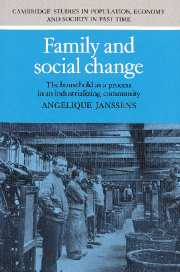Book contents
- Frontmatter
- Contents
- List of figures
- List of tables
- List of appendices
- Preface
- 1 Family and industrialization
- 2 The industrializing context: continuity and change in nineteenth-century Tilburg
- 3 Sources and methods
- 4 Family structure through time
- 5 Family life and the social structure
- 6 Family structure and geographical mobility
- 7 Family and work: the effect of the family economy on the structural characteristics of the household
- 8 Conclusion
- Appendices
- Bibliography
- Index
- Cambridge Studies in Population, Economy and Society in Past Time
4 - Family structure through time
Published online by Cambridge University Press: 05 March 2012
- Frontmatter
- Contents
- List of figures
- List of tables
- List of appendices
- Preface
- 1 Family and industrialization
- 2 The industrializing context: continuity and change in nineteenth-century Tilburg
- 3 Sources and methods
- 4 Family structure through time
- 5 Family life and the social structure
- 6 Family structure and geographical mobility
- 7 Family and work: the effect of the family economy on the structural characteristics of the household
- 8 Conclusion
- Appendices
- Bibliography
- Index
- Cambridge Studies in Population, Economy and Society in Past Time
Summary
In this chapter the results of the comparative analysis of the developmental family cycle of two age-cohorts of married couples in nineteenth-century Tilburg will be presented. This constitutes the first of the four strategies, discussed in chapter 1, that I have chosen in order to deal with the problem of the relationship between developments within the family and the process of social change. Here I will concentrate on the following question. To what extent did the second half of the nineteenth century and the beginning of the twentieth witness a decline in family cohesion, as expressed in the relative occurrence of extended kin in the household and the strength of generational links between parents and children? Methodologically, the dominant perspective is a dynamic one: co-residential family arrangements will be analysed over the course of the family cycle.
Family structure along the cycle
In chapter 1 the assumption made in traditional family theory, that the process of industrialization has a disruptive effect on kinship relations beyond the immediate family, was discussed at some length. According to one sociological theory, the internal dynamics of the industrial system required an occupationally and geographically mobile reservoir of workers. Hence, family solidarity in industrial society necessarily had to be restricted to the members of the nuclear family only. This was done by segregating the family from the economic system. Thus, the process of industrialization necessarily implied a process of nuclearization of the family group.
- Type
- Chapter
- Information
- Family and Social ChangeThe Household as a Process in an Industrializing Community, pp. 69 - 114Publisher: Cambridge University PressPrint publication year: 1993

